RESEARCH QUESTION
How can the inherency of materials found in a specific region facilitate the construction of a building element designed and made uniquely for the climate it is being used in and subsequently reduce carbon emissions?

Introduction
“Everything we design is a response to the specific climate and the culture of a particular place.” -Norman Foster
Architecture, through the medium of Material and design, has the ability to respond directly to its location and immediate microclimate. However, Industrialisation and modernisation have led every urban centre to be similar to the last, and hence lacking the essence that can define that city. Subsequently, we end up with buildings that poorly impact not only the aesthetics of the city but also its users and the environment. This can primarily be attributed to the choice of universally mass-produced materials and their inability to adapt to the immediate micro-climate. How can the cultural and climatic significance of architecture allow it to inherently adapt to its context and environment while creating a unique character?
The solution to sustainable architecture lies in historical practices and the use of natural materials. Natural materials, sourced from plants, animals, or the earth, offer unique qualities and can be replenished through natural cycles with minimal human intervention. Examples include timber, earth, bamboo, and others, found in regions based on microclimates and resource availability. Using local materials offers numerous benefits, such as environmental adaptability, reduced carbon footprint, cultural essence revival, and biodegradability.
By embracing vernacular practices and promoting local value chains, we can move away from unsustainable mass-produced materials. This shift towards sustainable, locally sourced architecture is imperative in the face of environmental challenges, preserving heritage while creating a more environmentally conscious and economically viable future.
The culmination of these methods, materials and approaches to design creates regional architecture that inherently responds to the climate, context and users for whom it is being built.
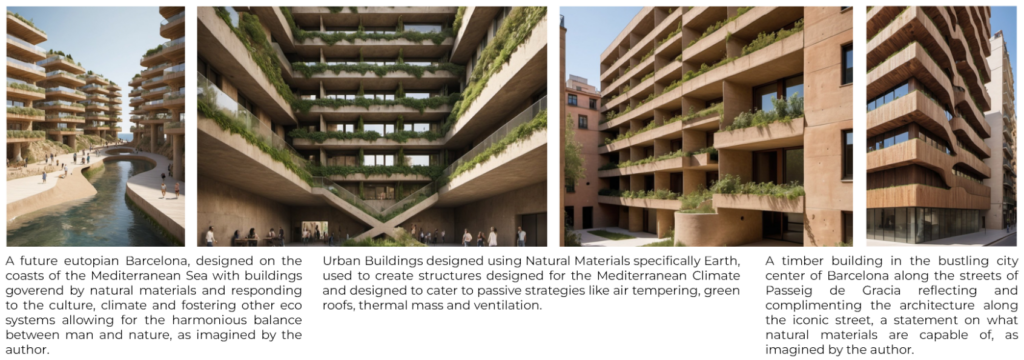
Earth is a material that is extremely diverse and unique from location to location. Subsequently, it becomes very difficult to standardise any process that requires locally available earth. Earth architecture is very similar to an artisanal skill, basing a lot of the knowledge on experience and intuition. Hence understanding the qualities of the earth being used and also the capabilities to use it in a particular technique will govern the type and nature of the additives used to stabilise this method of construction. How can this knowledge, which has been gathered over the years be used to create a solution that aids the understanding of the characteristics of the earth being used along with the additives needed and techniques that can be achieved with the same?
The assistive design tool that will be created will effectively aid the construction of region-specific earth construction facilitated by the inherency of locally available materials and techniques. Additionally, the prototyped building elements will hence serve as an example of what the potential outcomes could be following the Data script. This would serve as a manifesto that allows designers to find answers to aid their process of design and construction.
Hypothesis
The creation of a material tool that accesses and makes available data about natural materials, local building techniques and resources based on a specific local diaspora would allow for the creation of region-specific architecture that improves overall well-being while reducing the embodied carbon of a building.
Methodology
The study grows from the primary concern to understand how natural materials can used to combat climate change and in doing so make these materials accessible to users. The thesis pans from a macro-scale to a micro-scale. The approach begins with the understanding of natural materials and climates and their relevance to architectural strategies. This takes place through secondary research and drawing inferences from the same. The primary research takes place through individual interviews and surveys and then translates all the gathered information into an assistive design tool. The last part of the thesis focuses on using the tool as a user to see the outcomes it generates
The thesis is divided into 3 parts:
Part 1: Research & Inferences
Part 2: The Assistive Design Tool
Part 3: Prototyping & Testing
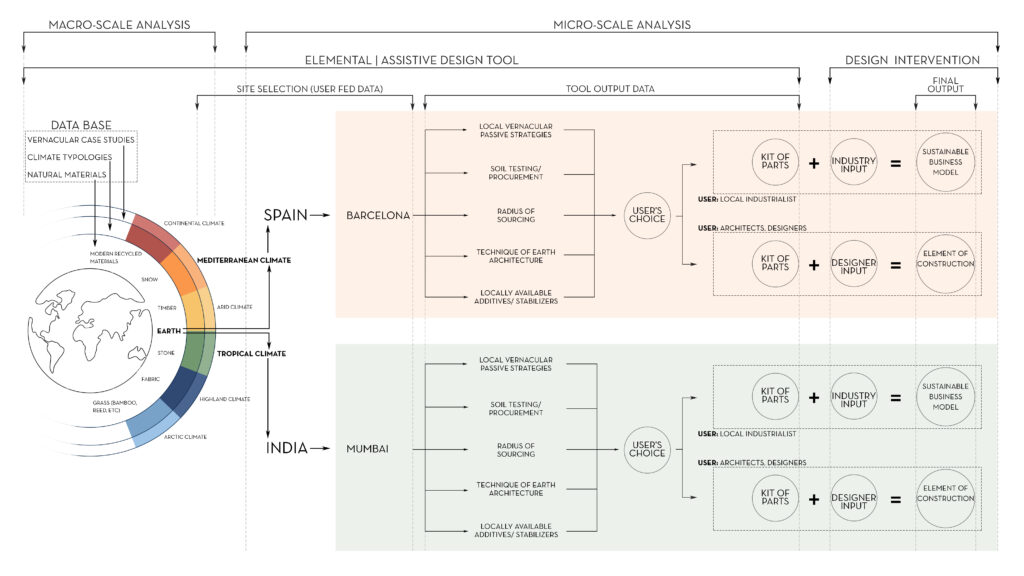

What is the current Issue?
With the building sector responsible for an astounding 42% of global emissions, the manufacturing of steel and cement in particular is a major contributor to global carbon emissions. These materials’ manufacturing methods, which require a lot of energy, are the cause of their significant environmental effect.
For example, the smelting process used in the production of steel mainly relies on coal and other fossil fuels, which contributes significantly to atmospheric carbon dioxide emissions. Another big offender is the cement industry, which produces significant amounts of carbon emissions by heating limestone and other minerals to extremely high temperatures. Cement production is actually one of the most carbon-intensive businesses, releasing roughly one tonne of CO2 for every tonne that is produced.
These emissions have serious and far-reaching effects. The emission of greenhouse gases, such as CO2, directly leads to climate change and global warming. Rising temperatures, an increase in the frequency of extreme weather events, and a decline in biodiversity are the outcomes of these effects.
Deforestation, habitat loss, and the depletion of natural resources are frequently associated with the extraction of raw materials for the production of steel and cement. Essentially, the environment suffers greatly as a result of the building industry’s significant reliance on the manufacture of steel and cement. In order to overcome these obstacles, a deliberate effort must be made to switch to more sustainable methods, like using natural materials, increasing energy efficiency, and advocating for the ideas of the circular economy. This raises the question,
How can the knowledge of Natural Materials be made accessible to everyone and subsequently reduce CO2 emissions?

Benefits of Natural Materials and Regional Architecture
NATURAL MATERIALS
After understanding the issues at hand it is imperative to find a solution to reduce the cement and steel needs in the field of construction. For the same, natural materials serve to be an answer to help combat this issue. Natural materials include Grass, Earth, Timber, Stone, Fabric, Snow, and Modern Recycled Materials. These materials are usually regenerative and renewable in nature and are produced through natural and organic sources.
There are several advantages to using natural materials in design that improve
human well-being and environmental sustainability. Here are a few main benefits:
- Environmental Sustainability: Compared to many synthetic materials, natural materials including wood, bamboo, straw, soil, and stone have a lower carbon impact. They create, process, and transport with less energy, which lowers greenhouse gas emissions.
- Renewability: A lot of natural resources can be farmed or gathered in a sustainable manner. For instance, wood can be obtained from forests that are maintained sustainably, encouraging the regeneration of the forest.
- Energy Efficiency: Natural materials are frequently very good at insulating. These materials result in buildings that use less energy for heating and cooling, which lowers energy consumption and lowers operating expenses.
- Carbon Sequestration: By absorbing carbon dioxide, materials like wood can lessen the effects of climate change. This indicates that even after the material has been taken and utilised for building, the carbon that the tree absorbed throughout its growth is still preserved there.
- Health and Indoor Air Quality: Compared to some synthetic materials, natural materials often have lower levels of volatile organic compounds (VOCs). As a result, residents can live or work in a healthier atmosphere with improved indoor air quality.
- Aesthetics and Biophilic Design: By adding warmth, texture, and a sense of being in nature, natural materials help create visually appealing and psychologically reassuring places. According to biophilic design principles, adding natural features to architecture can raise occupant satisfaction and output.
- Cultural and Regional Identity: Local customs and handicrafts can be preserved by using natural materials that are sourced locally. It also encourages the development of regional identity and a feeling of place in architecture, resulting in structures that blend in with their environment.
- Durability and Longevity: Many natural materials have exceptional durability when cared for properly. For instance, because of their durability and hardness, stone and clay materials have been employed in construction for millennia.
- Reduced trash: When it comes to construction, natural materials typically produce less waste than certain synthetic ones. Natural materials may occasionally be recycled or repurposed at the end of a building’s life cycle.
- Support for Local Economies: By encouraging the use of indigenous resources and lowering the need for long-distance material transportation, the use of locally available natural materials benefits local economies.
REGIONAL ARCHITECTURE
Architecture that responds to and reflects the unique geographical, cultural, and climatic conditions of its site is referred to as regional-specific architecture or regionalism in architecture. This architectural movement aims to design environments that are closely integrated with their surroundings by utilising the local resources, customs, environment, and cultural identity of a given area. Long-distance material transportation adds a substantial amount to carbon emissions. Regional architecture uses materials that are readily available near the construction site to mitigate this impact. In addition to lowering carbon emissions, this helps local businesses and encourages sustainability in the neighbourhood.
- CULTURAL PRESERVATION: Local architecture contributes to the preservation of a place’s distinct character and cultural legacy. Regional architecture honours the past and customs of a community by utilising locally sourced materials, inherited architectural features, and construction methods.
- SITE SPECIFICITY: Constructing in a way that is peculiar to a given region guarantees that the buildings are appropriate for the specific site circumstances. Considerations include topography, wind patterns, sun orientation, and views. As a result, structures are created that are both aesthetically pleasing and maximise the utilisation of natural elements for comfort and energy efficiency.
- COMMUNITY PARTICIPATION AND ENGAGEMENT: Regional architecture frequently entails working with local communities. In order to comprehend people’s requirements, preferences, and cultural customs, architects collaborate closely with them. The community members who benefit from this participatory method feel more linked to the structures and areas that are made for them.
- ECONOMIC BENEFITS: Communities may have positive economic effects from using local labour and building materials. It stimulates the local economy by fostering local businesses and craftspeople. Furthermore, building owners and occupiers may experience long-term cost benefits by implementing sustainable design principles and long-lasting materials.
- AESTHETIC APPEAL: Buildings with regional architecture are frequently aesthetically arresting and distinctive in their setting. A region’s overall aesthetic can be improved by including locally produced materials and design features that evoke a feeling of place and beauty. Both tourists and a sense of pride among locals may benefit from this.
- HUMAN COMFORT AND WELL-BEING: The comfort and well-being of residents are given first priority in regional architecture. The year-round comfort of spaces is emphasised through the use of natural light, ventilation, and outdoor connections. Residents’ and users’ quality of life may be improved by this.
- ADAPTABILITY AND RESILIENCE: Architecture unique to a region may frequently adjust to changing circumstances. Structures are made to endure regional weather patterns, natural calamities, and changing community demands over time.
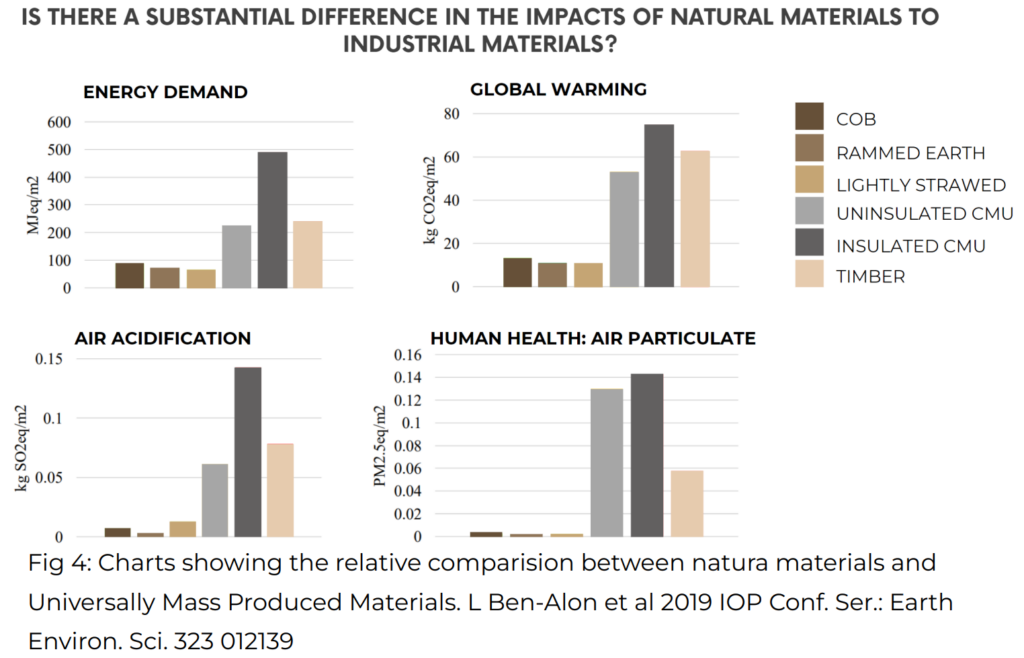
State of the Art
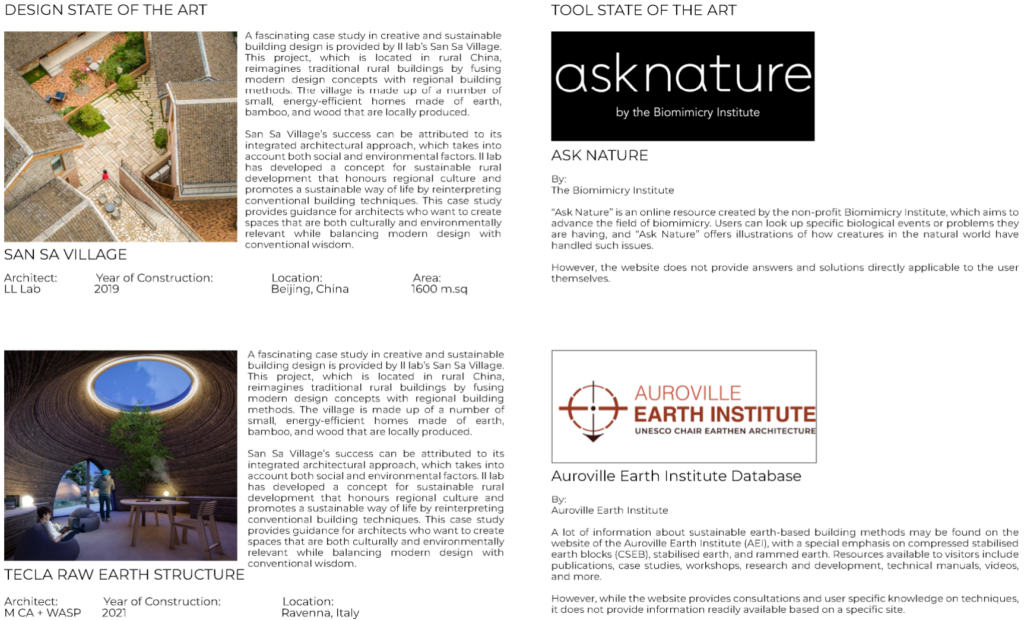
Why Earth?
One of the biggest concerns of the twenty-first century is reducing the environmental impact of anthropic activities, and the construction sector is crucial to this effort. About 40% of energy-related carbon dioxide (CO2) emissions and 36% of global final energy use were attributed to the building and construction industry in 2017.
Earth as a raw material is one of the largest available resources with a very low embodied energy. Earth architecture is one of the most predominant forms of architecture with more than half of the world’s population living in earth-constructed structures. However, when one mentions Earth architecture today, we are stigmatised to imagine a primitive house one that often is unable to meet the advancements of modern urbanisation. While Earth may still have certain limitations to construction, there have been huge advancements made in the field to allow Earth architecture to stand its ground in the face of industrially mass-produced materials.
Earth serves many benefits through its Hygroscopic properties, Heat transfer, Thermal mass and humidity control. The material is inherently recyclable and biodegradable while being adaptable to all climate zones serving temperature control based on the need.
- Earth is versatile, natural, recyclable, and generally an abundant material.
- Earth requires little energy to extract and prepare for use in construction while having low embodied carbon.
- Soil is decomposed plant material. This means that the earth contains all the carbon that the plants absorb from the atmosphere during their lifespan. Hence, the earth can “sequester” or store this carbon for a very long time, particularly in colder locations where decomposition is slower.
Obstacles Faced in large-scale Earth Construction
Based on conversations with several experts in the field of Earthen Architecture namely, Michael Salka, Christian Schmitt, Felix Hilgert & Yelda Gin, there were several factors that came to light. These are hindrances that exist in the current field of Earthen Architecture.
Difficult to Industrialize: With only 1% of the market using Earth Architecture, Industrialists find it unnecessary to create a value chain. Additionally, due to its constant variability, it is difficult to find a single value chain.
High Cost for Construction: Due to the lack of industrialization, the cost of production and labour is significantly higher than universally mass-produced materials. This is another reason people do not opt for Earth.
Lack of Knowledge & Resources: There is a lack of awareness about the material. There are knowledge gaps and available resources are difficult to come by.
Socio-Economic Conditions: Developing nations are more likely to use Earth as a material due to the lower cost of labour and would find automated systems of earthen architecture difficult to afford and vice-versa in the case of developed nations.
Lack of Building Standards: There are very limited resources on the knowledge and application of earth as a modern-day material. This is further established by the lack of building standards making it difficult for people to trust the material.

Stabilizers & Additives
Chemical stabilisers are frequently applied to enhance their mechanical performance and longevity. The primary disadvantages are the significant harm that their manufacture causes to the environment, their decreased capacity to be recycled, and the potential loss of raw earth’s hygrothermal qualities. In the past, the earthen matrix was stabilised through the incorporation of biopolymers, various fibre types, and agricultural wastes.
With the rise of urbanization, there is a steady rise in the use of artificial stabilizers and additives in Earthen Architecture. These impact the material properties of the earth and also reduce the recyclability and increase the negative impact on the environment & and in post-life use.
There are several advantages to using natural additives and stabilizers. These improve the impact on the carbon footprint the finished material has.
- 100% Recyclable: When naturally stabilized, earthen architecture is completely recyclable and can go back to the planet while posing no harm.
- Climate Control: The material has a high thermal mass making it suitable for climates ranging from hot to cold. It also regulates indoor conditions with temperature and noise control.
- Low Carbon Emissions: Due to the low energy required for extraction & and construction. Additionally, excavated soil from construction sites can also further help reduce carbon emissions.
- Life Cycle Costs: The material is cheap to procure & helps regulate temperature and reduces energy requirements, hence significantly reducing the lifetime costs for the building.
- Safety and Health of Building and User: Earthen buildings have high fire resistance due to the lack of combustibles. The porosity and breathability of the material also help purify the internal air ridding it of toxins.

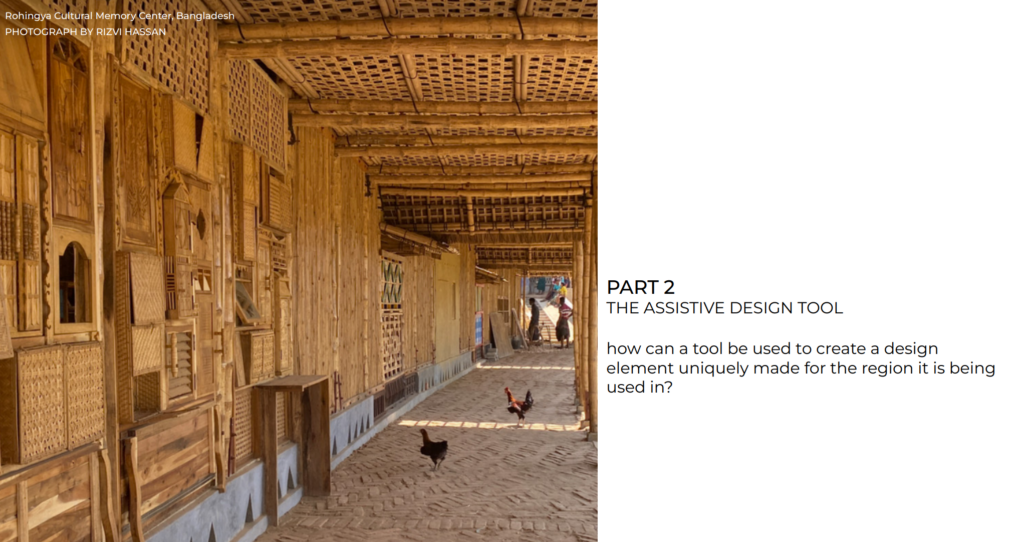
Macro-Scale Analysis
GLOBAL CLIMATE ZONES
Global climate zones have a significant impact on architectural design and construction practices. These zones are typically classified based on temperature, humidity, precipitation, wind patterns, and other climatic factors. The following are how different climate zones influence architecture:
- Arctic Climate: Architecture in Arctic regions must withstand extremely cold temperatures and harsh weather conditions. Buildings are often designed to be highly insulated and airtight, with minimal windows to reduce heat loss.
- Highland Climate: Architecture in mountainous regions varies depending on altitude and local climatic conditions. Hence, requiring robust construction techniques and materials that can withstand such conditions.
- Tropical Climate: Buildings in tropical regions with high temperatures and humidity often incorporate features to promote natural ventilation, such as open floor plans, elevated structures, and large windows for cross ventilation.
- Arid Climate: Architecture in hot and arid tropical climates focuses on providing thick walls made from materials like adobe or stone to maintain cool indoor temperatures, along with courtyards or covered outdoor spaces for shade.
- Mediterranean Climate: In this climate zone there is a drastic difference between summer and winter temperatures. Hence, the structures require flexibility from one season to another. Green roofs, thermal mass, and air tempering are common.
- Continental Climate: In regions with mild temperatures and moderate rainfall, buildings often prioritize energy efficiency and comfort. Architecture in cold continental zones emphasizes insulation and protection against harsh winters.


GLOBAL VERNACULAR ARCHITECTURE TABLE
The term “vernacular architecture” refers to a kind of local or regional structure that uses customary materials and resources from the surrounding area. As a result, this building is deeply rooted in its environment and cognizant of the unique topography and cultural elements that surround it, having been greatly impacted by them. They are therefore exclusive to many regions of the world and can even be used to reinforce an identity.
Paul Oliver’s research succinctly describes it as an architecture that includes people’s homes and other structures related to their local settings and resources, typically constructed by the owners or the community using traditional methods. It is designed to fulfil certain requirements and fit the economics, morals, and way of life of a particular culture.
Vernacular architecture can be considered to be traditional in the sense that it comes from certain ethnic groups and is the outcome of a protracted process over time, always built upon recognizable forms set by earlier generations. In addition, as was already noted, vernacular architecture honours regional characteristics, emphasizing how sensitive it is to the surrounding area’s physical environment, which includes topography, vegetation, and climate.
Given that these structures have excellent bioclimatic qualities and are true instances of architectural sustainability, vernacular architecture has been explored and reconsidered in many modern architectural practices. As such, they play a significant role in contemporary society. This is the reason why historical architectural strategies are being researched and applied in projects that try to minimize CO2 emissions to the environment while optimizing energy efficiency, for example, through passive noise and heat management.
The following Data is collected through first-hand research of the Case Studies culminated from the books titled “Buildings without Architects” by John May & ‘Architecture without Architects” by Bernard Rudofsky.

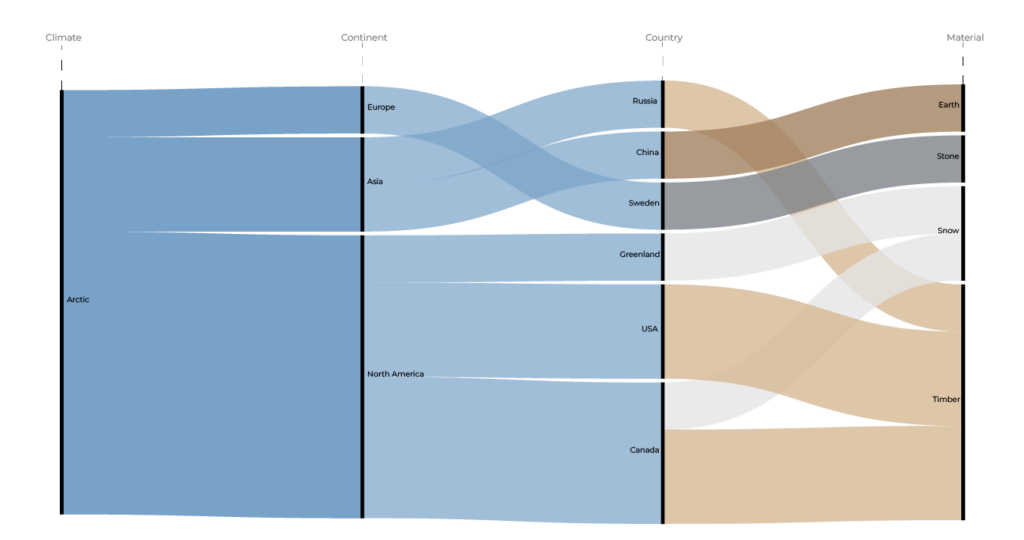

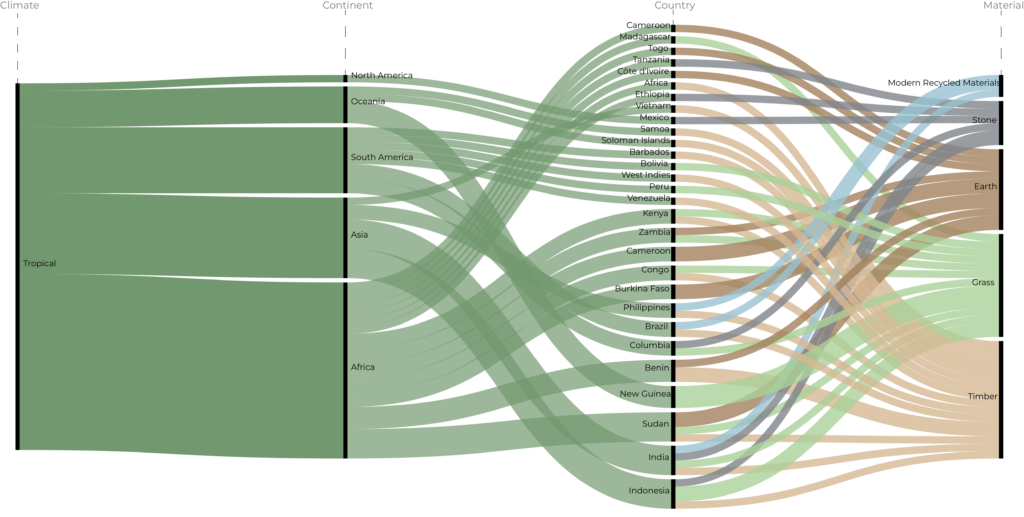
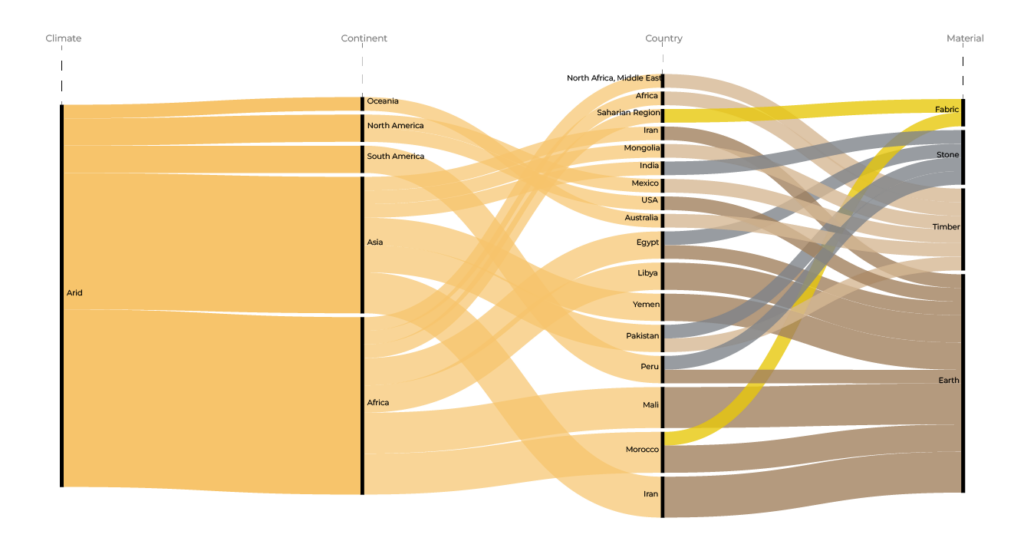
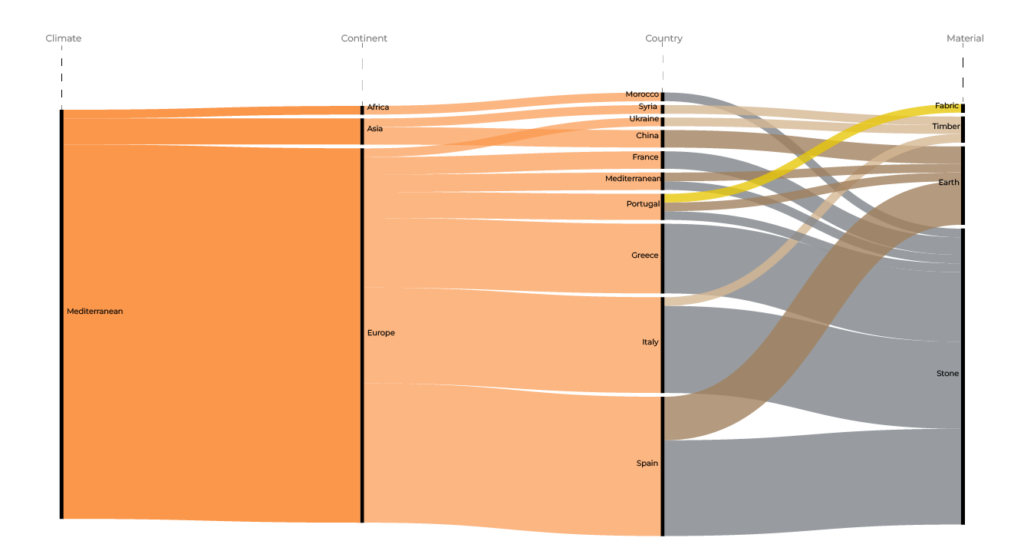
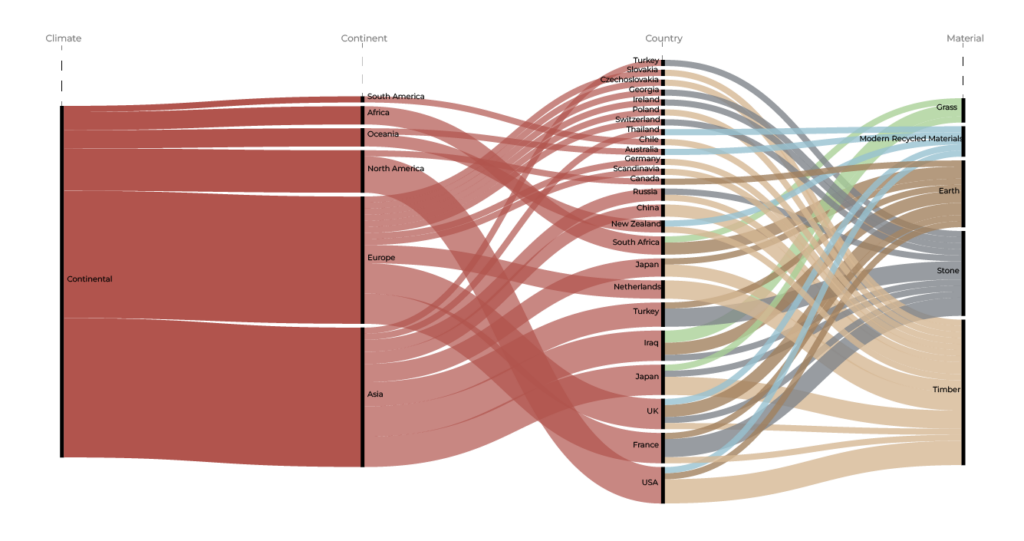
Natural Additives, Stabilizers & Earthen Techniques Table
While there are strides in using earth architecture, however, one downfall is the use of artificial stabilizers. These have a poor impact on the carbon footprint and reduce the recyclable property of raw earth architecture. This is where natural additives are revolutionary, they are usually cost-efficient, renewable increase indoor health, reduce energy loads and are flexible based on the need of the material. These stabilizers when treated correctly often have the same compressive strength and load-bearing properties as artificially stabilized earthen architecture.
Hence, the use of natural additives in earth construction represents a shift towards more sustainable, environmentally friendly, and culturally rich building practices, offering a range of benefits from reduced environmental impact to improved comfort and health for occupants.

Elemental | The Assistive Design Tool
Elemental is an assistive design tool to aid the processes with finding information on viable options for natural material processes for the user’s region. This is achieved through the user answering a few questions and then receiving data based on the answers provided.
The tool facilitates the use of regionally acclimatized natural materials which helps bring down CO2 emissions reduce the negative impacts on the environment and improve post-life impact. An independent survey was conducted among people in architecture, construction and other adjacent fields. The survey asked questions about natural materials and their application in the industry. Surprisingly there was a 100% agreement that Natural materials should be introduced into the industry. However, there was hesitation when asked if they would use these materials themselves. When asked if they would likely use these materials when assisted with a tool that would help them along the process of working with these materials the rates were higher.
BENEFITS OF ELEMENTAL:
- PRIMARY BENEFITS: Natural Material Awareness, Aid reduce CO2 emissions, Make regional architecture accessible.
- SECONDARY BENEFITS: Promote local supply chains and hence increase job opportunities, Introduce earthen architecture to the urban diaspora.
- TERTIARY BENEFITS: Reduce production of universally mass-produced materials.
The tool is designed in a manner where several layers of filters are applied to aid in shortlisting the recipes based on the database and user feedback.
FILTER 1: CLIMATE
In this filter, the user feeds in the data of the country they are running the system for. Eg. Spain. At this point, the tool will provide the user with the climate map and the list of vernacular case studies for this climate typology.
FILTER 2: LOCATION
Next, the user will be asked to feed in the name of the city they are working in. Eg. Barcelona. The tool will now provide the user with the country, state and city maps.
FILTER 3: SOIL STUDY
Based on the location fed in at the previous filter, the tool now generates the soil map for the country along with a general analysis of the soils available in the particular city.
FILTER 4: TECHNIQUES
Based on the city guidelines, soil qualities and other parameters, the tool will generate a list of techniques that are possible in this particular location.
FILTER 5: RADIUS OF MATERIALS
At this stage, the user is asked to give the exact location of the site they will be working on and is asked to select the radius of sourcing they want.
- 5 Mile – According to Gandhi’s Philosophy, a house should be built from natural materials that are procured within a 5-mile radius of the site. This is done because, within that 10-mile limit, the climatic conditions are extremely similar in nature, hence the material when implemented in the building would adapt and respond well to its environment.
- 50 Mile – Owing to urbanization, better infrastructure and better methods for the procurement and sourcing of materials, the Gandhian philosophy can be translated into a greater distance of 50 miles that allows for better implementation and sourcing of natural materials without greatly increasing the drawbacks in terms of carbon emissions and cost.
- 100 Mile – The 100-mile house is a concept that promotes the use of building materials within a 100-mile radius, this promotes the local economy while preventing the carbon emissions caused by the shipping of materials. This larger radius also allows for a greater choice of materials.
FILTER 6: ADDITIVES
Basis this information, the tool generates the map for marking the site with the radius and highlights all additives found in that radius locally.
FILTER 7: RESOURCES AVAILABLE
The next step requires users to select all resources and tools available to them or tools they can easily get access to.
FILTER 8: SHORTLISTED SYSTEMS
Finally, with all the filters applied, the user is presented with a list of earthen architecture techniques and recipes that are possible given the various parameters. The user then selects one and is provided with a consolidated docket with all the information and steps on how to construct using this system.

Link to Website Prototype: https://www.figma.com/proto/GNL7XKUcrUEXETkla7dMpx/Elementary-Prototype?type=design&node-id=6-3&t=pp43vRPkh5yZD1Zf-0&scaling=scale-down&page-id=0%3A1&starting-point-node-id=6%3A3
FUTURE SCOPE
- The tool currently at a global scale functions only at a macro scale. However, in the future, the aim is to develop the entirety of the system to function at a global scale. To achieve this the system proposed to be applied is to involve other businesses and individuals in this process to gather information on the same for their region allowing this to be a global community project.
- The next would be to expand this system into other natural materials like timber, grasses like reed and bamboo and other materials.
- The hope is to get investment from local businesses to appear in the additive mapping allowing their business to get exposure to a new stream of clients and opportunities.
- As for the design of the element of construction. Users will have the ability to send their data for the material and element to the creators allowing for it to be verified and then fed into the system for other users to have a better evaluation of the recipes they choose creating a holistic tool that achieves a better healthier construction system.
ELEMENTAL an effort to re-establish the roots that entangle cultures…
Micro-Scale Analysis
Elemental is a tool designed for the user to interact with it and generate answers based on the specific location of where they intend to design. Keeping this in mind it is imperative to first understand the framework of the tool and then apply it to a site to measure the efficiency of the proposed framework and make any modifications based on the same. For the same the two locations chosen are Barcelona & Mumbai
BARCELONA
Barcelona was chosen primarily due to the immediate accessibility since the thesis is being conducted here. This allows the author immediate access to local information and resources. The tool’s framework was designed using Barcelona as the test subject. Through a process of trial and error, a system of filters was designed to aid the user in narrowing down choices based on their location, access to resources and climate to name a few. The final workflow was then tested using the data for Barcelona to provide vital information to the users.
MUMBAI
Once the workflow was determined it needed to be tested for another location to ensure a systematic flow of information. For the same, the location chosen was Mumbai. Mumbai was chosen because the author originates from this location and information and data were easy to access. Another important factor for the choice was that of its climate. It has a tropical climate which is different from the Mediterranean climate of Barcelona and hence the simulations run would have to provide answers for two different climates and locations to test its efficiency.
The following shows the information provided by the tool based on user input and the existing database. The simulation is run side by side to allow readers to compare the data provided for Barcelona and Mumbai.
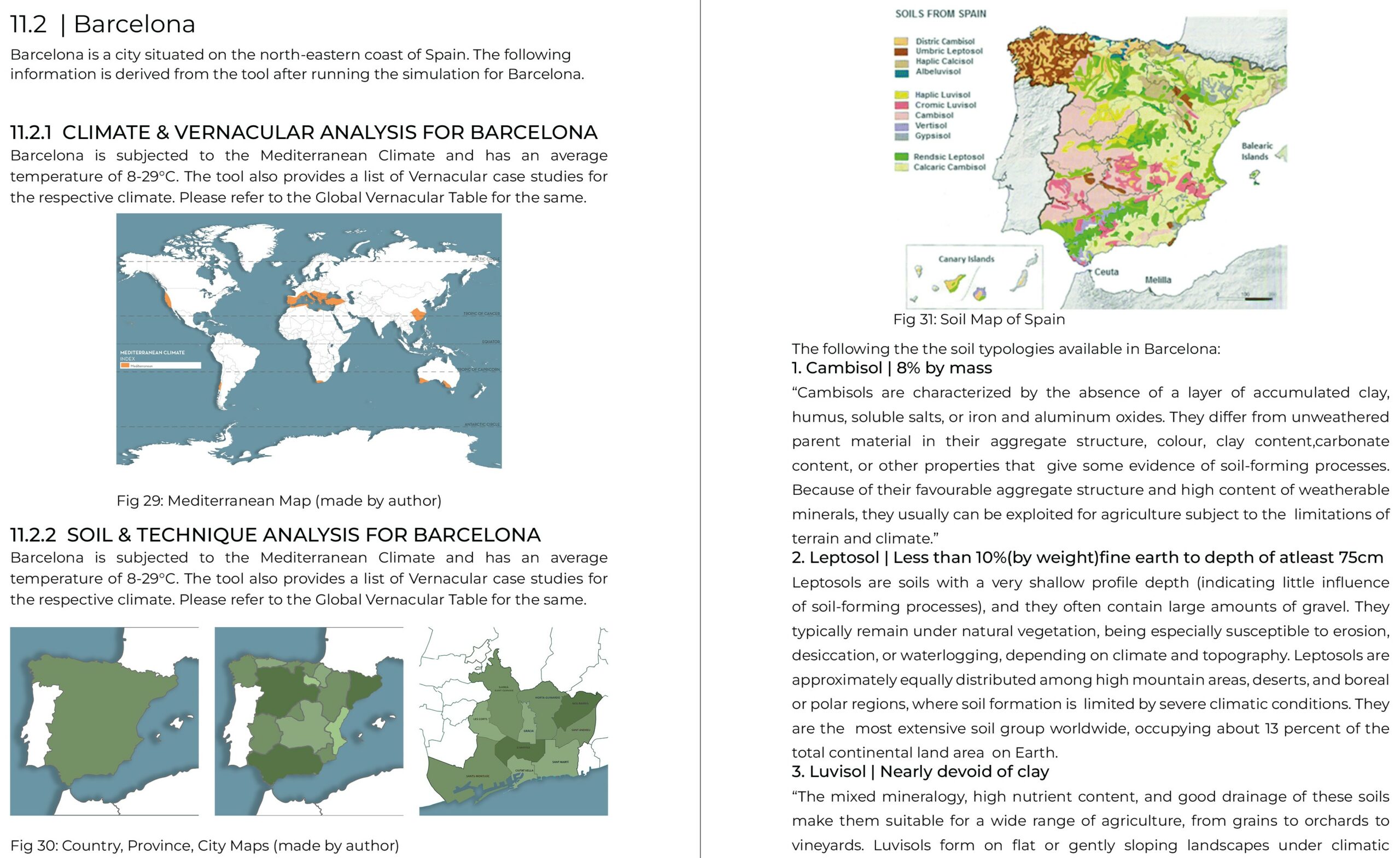
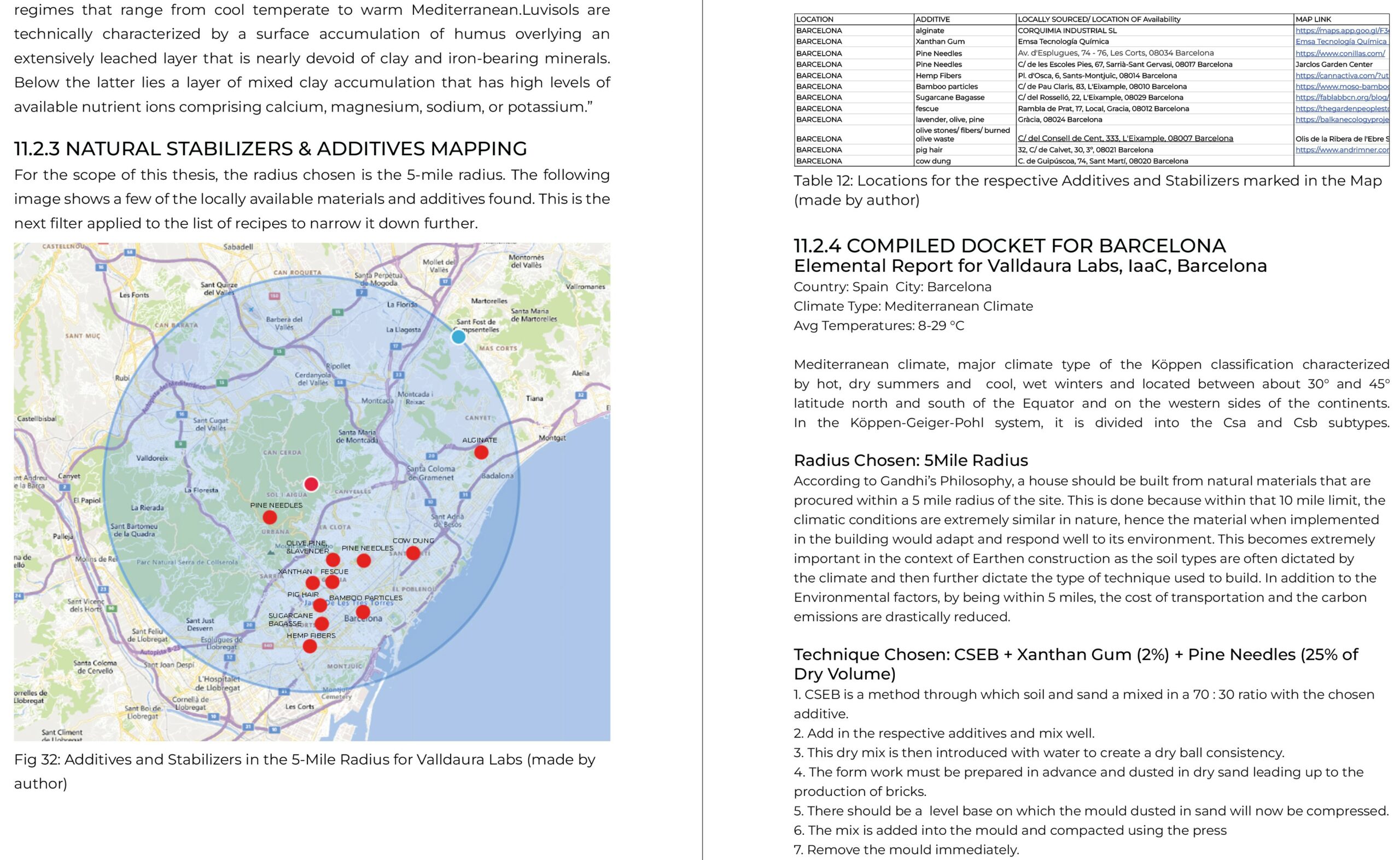
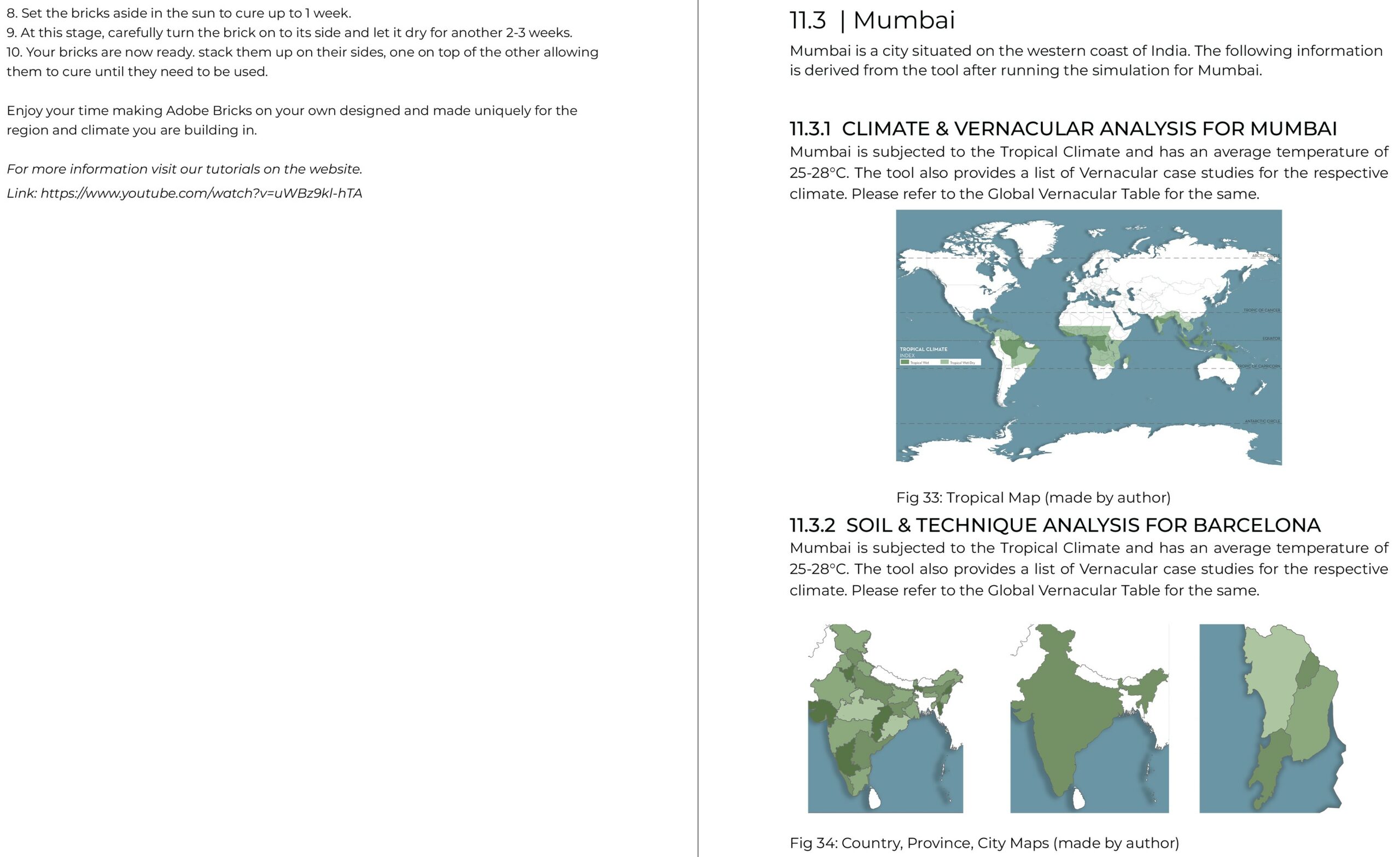
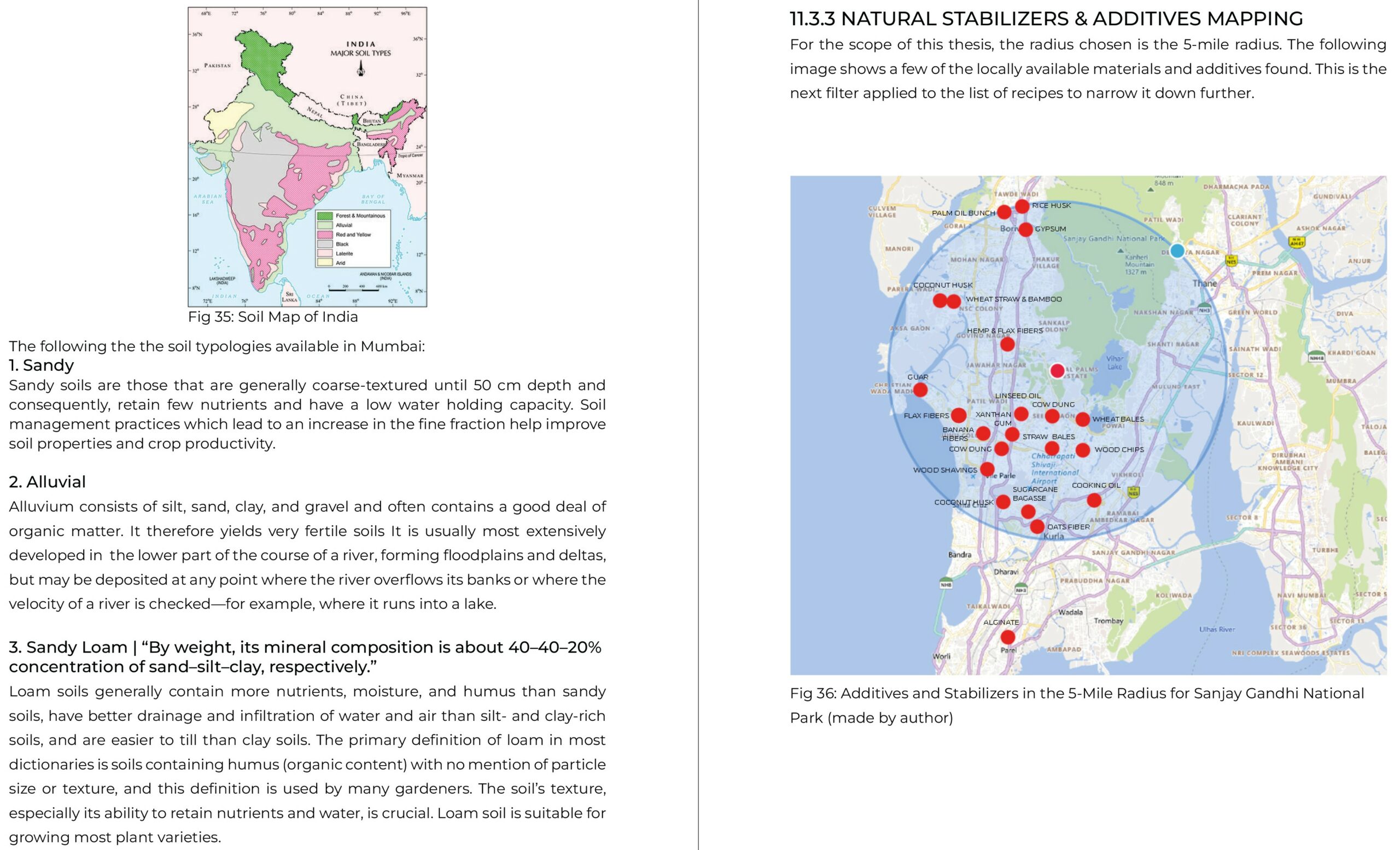
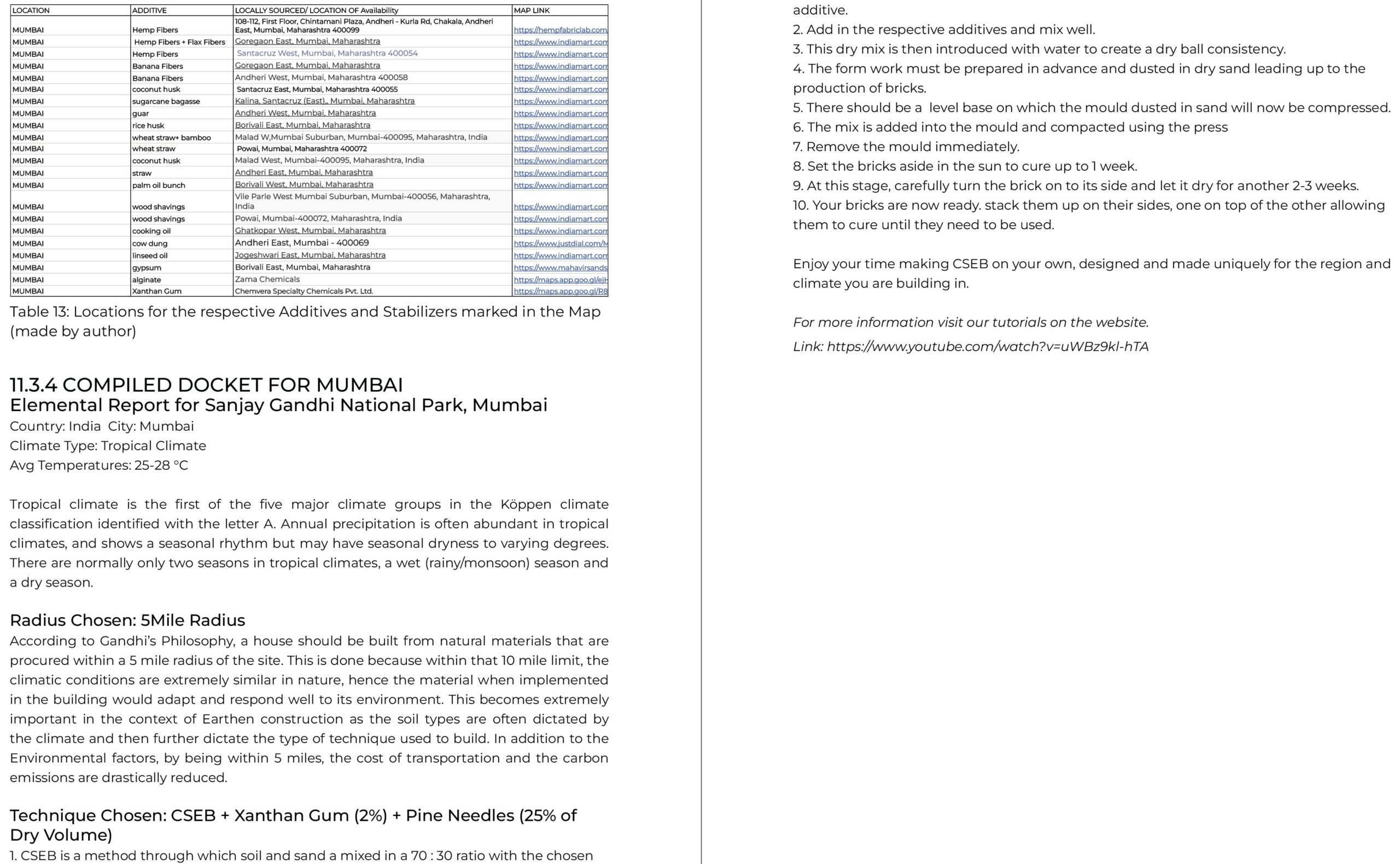

Material Testing and Analysis
Through the simulations run for both Barcelona & Mumbai in the Elemental Prototype, several recipes with their corresponding techniques were generated. Off these recipes, the technique chosen was Compressed Stabilized Earth Blocks. This was primarily chosen due to the availability and access to resources in Valldaura Labs.
Following the selection of the Technique, the next step would be to determine an appropriate recipe from the list of additives and stabilizers provided by the tool.
CSEB as the name suggests requires the use of soil stabilization. For the same, the tool generated the use of Xanthan Gum and Alginate as potential stabilizers that are naturally available and produced in both cities. In addition, to improve other properties a choice needed to be made on potential additives. For the same from the Designer’s perspective, there are tests that will be run to understand the characteristics and capabilities of the different recipes and test them to understand how they compare to the conventional recipes and solutions. This information will be fed back into the system and will provide users with added data on these particular recipes and ingredients. A similar approach will be proposed for future development allowing research on recipes to be fed back into the system to aid the users in their choices.
WHY ARE WE TESTING?
The tests are being run to understand the comparative analysis between non-stabilized, lime-stabilized and naturally-stabilized earth blocks. The parameters for testing will be:
PRODUCTION | This parameter tests the time for production and ease of production through the process from the creation of the mould to the brick being unmoulded and set to dry.
HYGROSCOPIC PROPERTIES | This parameter will be analysed by placing the blocks in water for a span of 1 hour to track the physical condition and amount of water absorbed.
MECHANICAL PROPERTIES | The blocks will be passed through a compression press to track the load that is tolerated till cracks are developed. This will give an understanding of the block’s compression strength per m2.
A factor to account for is that all the blocks were compressed with the use of the CLT Press available in Valldaura Labs which does not provide the same degree of compression as the CEB Press and the blocks were only curred for a span of 2 Days due to the time restraints. As a result, the values generated from the tests need to be read keeping these factors in mind. However, due to these parameters being constant for all the bricks, they can be analysed in comparison to each other to derive an accurate comparative reading.
In the future, these tests will be redone with the correct tools and accurate curing time.
WHY XANTHAN GUM?
Off the suggested natural stabilizers (Alginate & Xanthan Gum), Xanthan is chosen to study in detail for the scope of this research. Xanthan is chosen due to its lower requirement of Material. The recommended amount of Xanthan is 2% to the 19.75% of Alginate required in one block to receive similar results. Xanthan will be tested individually without additives and will also be tested in the two iterations with additives.
Alginate, however, is being tested only in a single block to compare directly to only the Xanthan Block. In future scope, the Alginate will also be tested with the different additives,
WHAT SOIL?
The soil used for the Material Testing and further prototyping is done using soil collected from the forest of Valldaura Labs. This soil was then Bottle Tested.
A bottle test requires the user to fill the bottle with 60% soil, a few drops of dish soap and 40% water. After shaking the bottle set it aside for a few days. The results show the clean separation in the soil components. After analysis it can be determined that the soil is CLAYEY in nature.


PRODUCTION

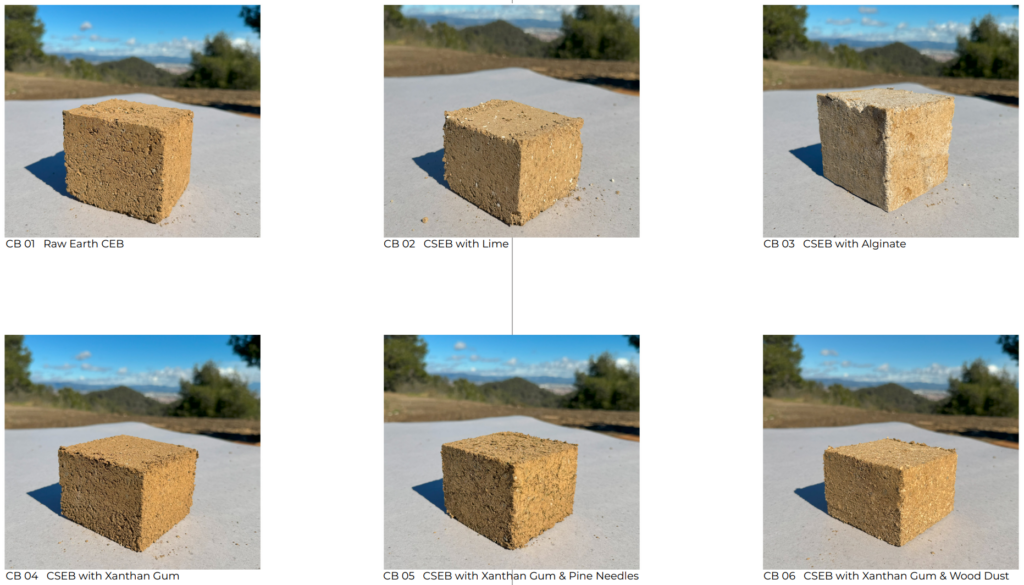
HYGROSCOPIC PROPERTIES
The current data on Xanthan Gum and Alginate fail to show any tests and research into the Hygroscopic Properties of Stabilized Earth bricks using the aforementioned stabilizers. As a result, the thesis looks into testing the material at a holistic scale to better understand the true potential of the materials.
For the same, each brick was placed in a container with water for the duration of 1hr. This recorded the amount of water absorbed by each block to understand the water absorption and their affinity to water.
A factor to account for is that all the bricks had a cure time of 2 Days. These results may vary after the complete cure time is met.

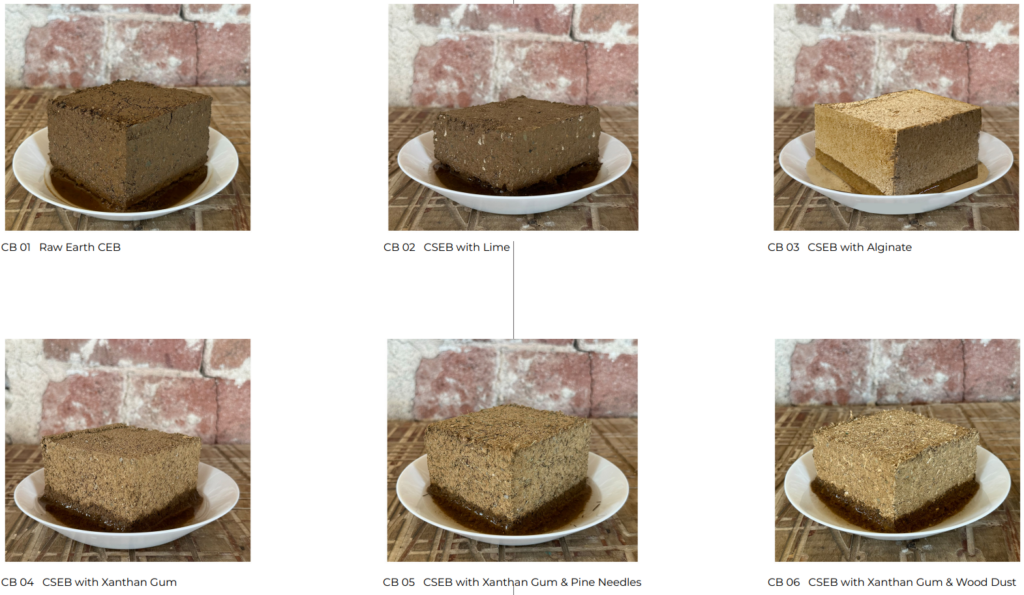
MECHANICAL PROPERTIES
The Bricks were load-tested to understand their mechanical properties based on the stabilizers and additives added. These bricks were then placed in a compression machine to load test them till failure.
Each brick was curred for three days and the results need to account for the same. To make it easier to understand the bricks were analysed using a Relative Load Capacity Index. This is done keeping in mind that the only variable factor between the bricks is the additives and stabilizers while all other parameters remain constant.


Climate-Specific Earthen Proposal
BARCELONA
Based on the Tool’s feedback, the research is taken and applied from the point of view of a designer. The building element is uniquely designed for the microclimate of Barcelona and is designed keeping the passive strategies, material selection and tool feedback in mind.
Taking inspiration from the vernacular case studies and local techniques of the Mediterranean Climate, there are 7 primary passive strategies to account for when designing a thermodynamic and sustainable project:
- THERMAL MASS: The earth block retains heat during the day and releases it at night to help balance the temperature fluctuations.
- VENTILATION & AIR TEMPERING: The air must be tempered prior to entry into the house. This requires cooling the air in summer and warming in winter.
- GREEN ROOF & HUMIDIFICATION OF AIR: The Mediterranean Climate is known for its dry air and lack of humidity. Green facades humidify the air prior to entry.

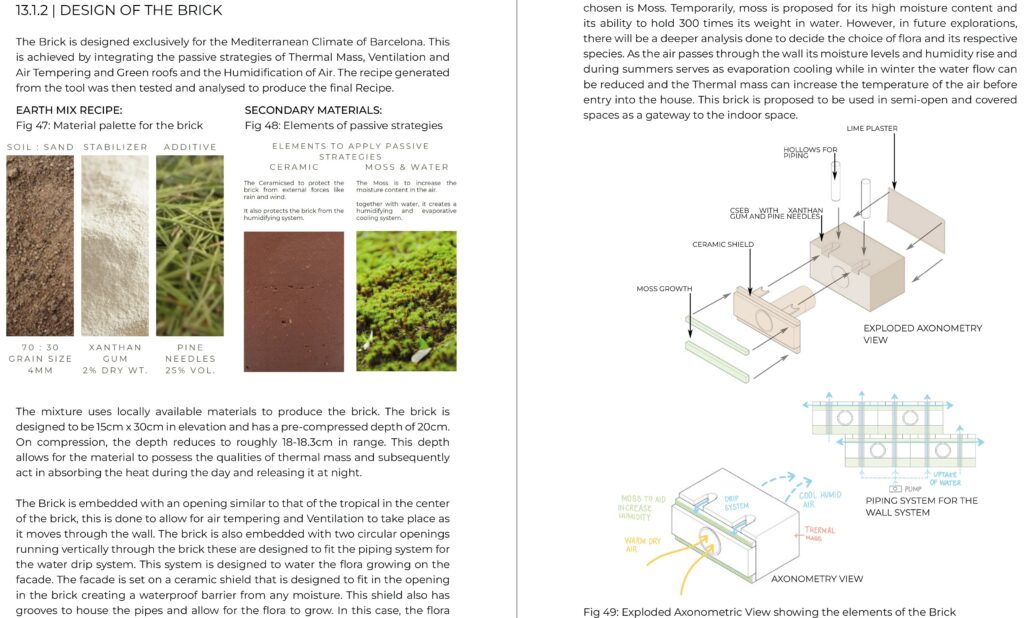
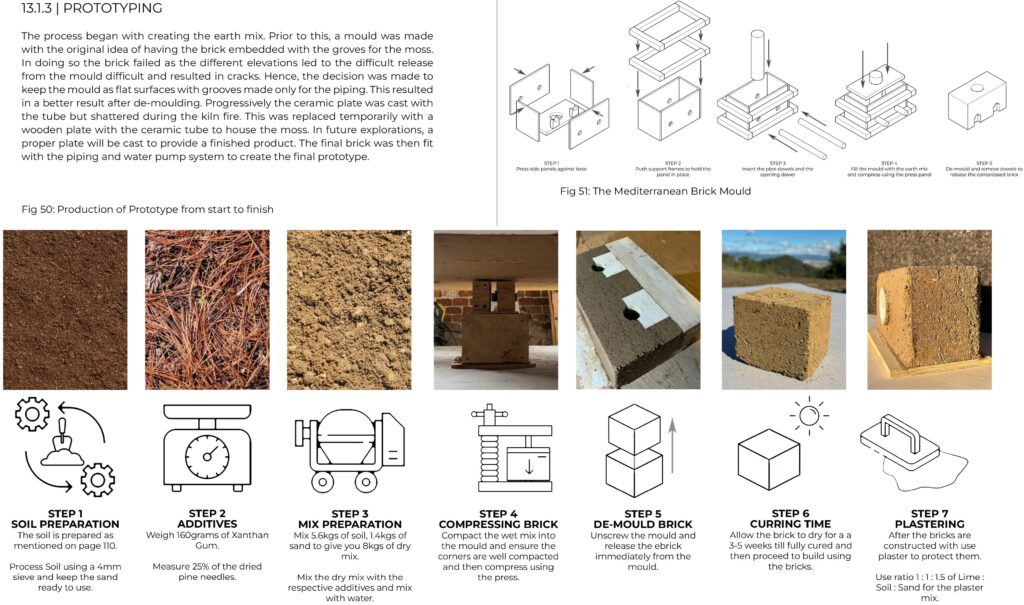
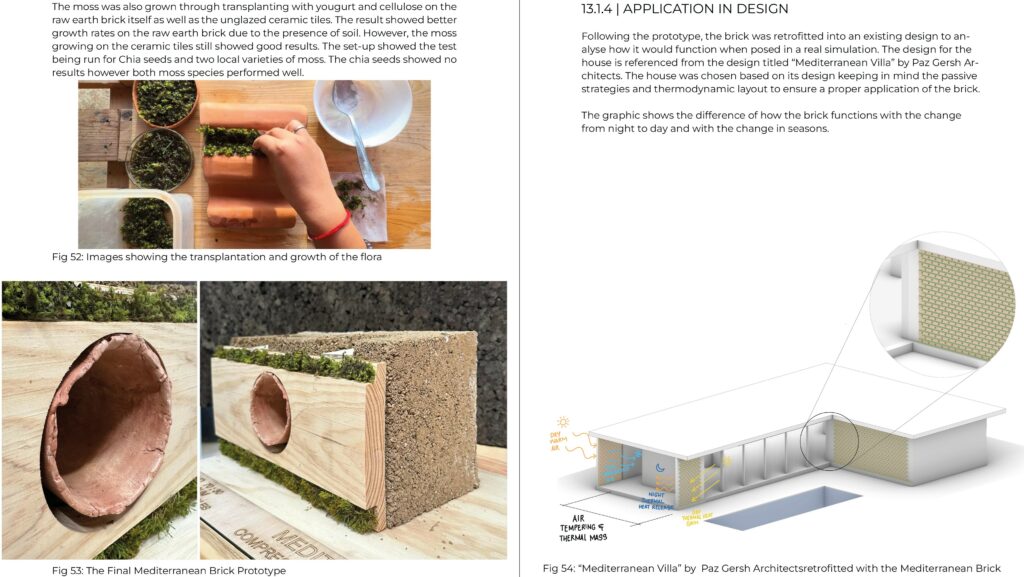
MUMBAI
Based on the Tool’s feedback, the research is taken and applied from the point of view of a designer. The building element is uniquely designed for the microclimate of Mumbai and is designed keeping the passive strategies, material selection and tool feedback in mind.
Taking inspiration from the vernacular case studies and local techniques of the Tropical Climate, there are 7 primary passive strategies to account for when designing a thermodynamic and sustainable project:
- PASSIVE COOLING: Using the concept of the Venturi Effect, the air is pressurized through a telescoping channel to cool.
- CROSS VENTILATION: The openings allow for the wind to flow through the house constantly taking out the warm air.
- DEHUMIDIFICATION OF AIR: The air in tropical Climates is known to have high humidity. The dehumidification through salt creates a comfortable surrounding.

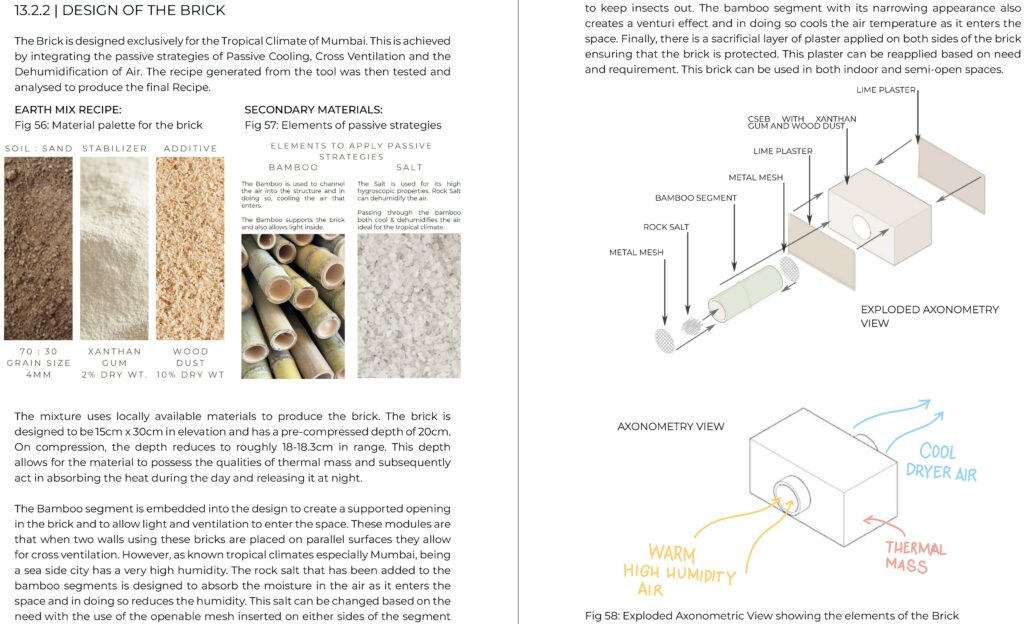

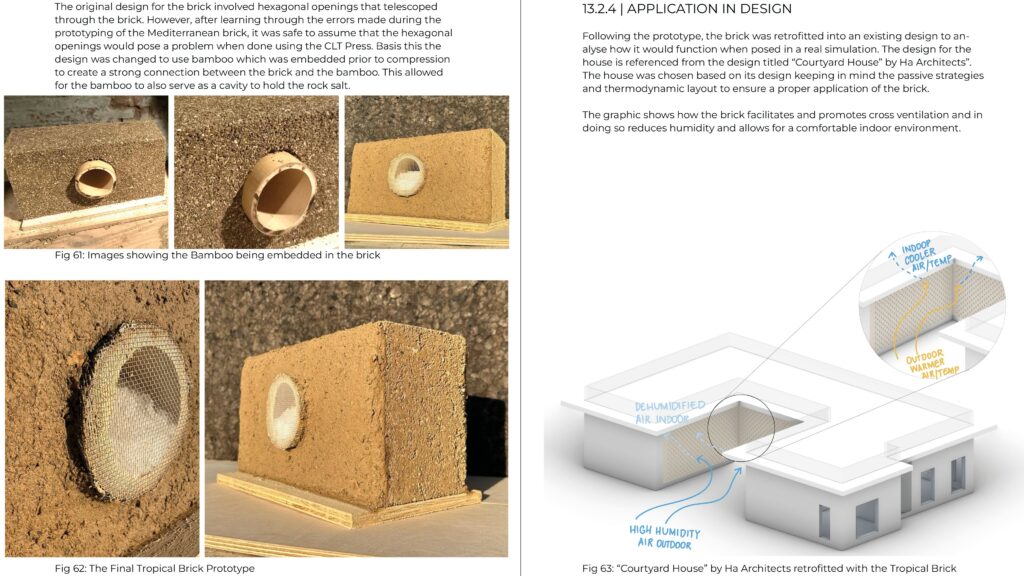
FUTURE SCOPE
Following several attempts and failures, the final bricks produced were moulded accurately to the design. However, the final bricks did possess a few issues such as uneven shrinkage on the plaster and minor fractures.
Moving forward the bricks will be re-casted and reassessed potentially using a finer grain size and also adjusting the curing times accordingly. Additionally, these new bricks would then be tested after the complete curing time on parameters such as Compression Loads, Hygroscopic Properties, Ease of Construction and Weathering.
In subsequent testing, the efficiency of the brick will also be tested to see if these passive strategies integrated into the design possess the ability to make thermodynamic changes in the chosen environment. This will be done through a test to comparatively measure the outdoor humidity and temperature and compare it to the indoor humidity and temperature when the air passes through the brick. The desired results, in the case of the Mediterranean Brick, would show a rise in indoor humidity and temperature, and in the case of the Tropical Brick would show a fall in indoor humidity and temperature.
These results with the learnings and analysis will be fed back into the system to provide users with additional information on the material properties and also a potential design they could apply to their structure. Similarly, as users use the tool, they have the option to feed information on the material and design back into the system upon verification to ensure that the tool and its scope keep growing with every use.

REFLECTIONS
The trend towards using natural materials in design appears to be a powerful response to growing concerns about global warming. By considering regional architecture and local materials, this strategy not only solves urgent environmental challenges but also improves the quality and impact of architecture. Architects may design buildings that are not only aesthetically pleasing but also robust, sustainable, and intimately integrated into their environments by utilising natural materials.
Building materials made of natural elements have been used for ages, including clay, straw, stone, wood and bamboo. Their natural qualities provide numerous advantages in the fight against global warming. Natural materials generate less greenhouse gases and have a far lower carbon footprint than their artificial counterparts, making them intrinsically more carbon neutral, and environmentally friendly throughout their existence, from the extraction procedure to the conclusion.
By doing this, Elemental aims to bring together these qualities of natural materials and present them to the user in a way that lets them utilise the resulting material in a way that best suits their specific site. This makes it possible to employ natural materials and makes regional architecture easier to create.
Natural materials have the important benefit of being able to sequester carbon. Utilising natural materials also encourages energy efficiency. The significance of natural materials is accentuated in regional architecture. By drawing influence from the local climate, culture, and resources, regional architecture aims to blend in with the surroundings. This technique produces structures that are both aesthetically beautiful and firmly anchored in their surroundings.
In conclusion, incorporating natural materials into architecture offers a strong response to the problems caused by global warming. Using local materials and emphasising site uniqueness, regional architecture allows architects to design robust, sustainable, and culturally meaningful structures. This strategy opens the door for a more sustainable and peaceful built environment by lowering carbon emissions and energy use while simultaneously improving the architectural quality for both users and the environment.

